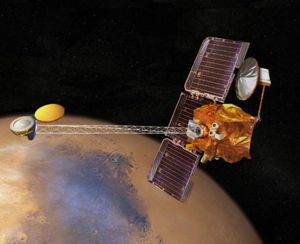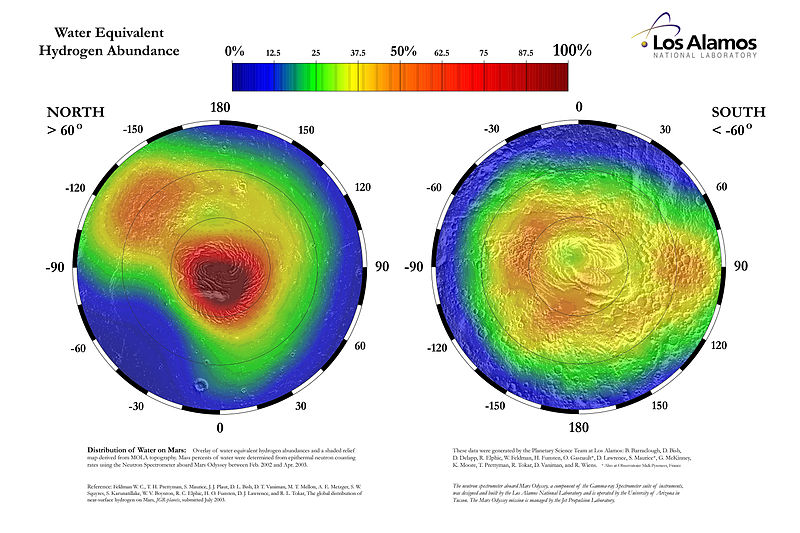Mars Odyssey
| This article is a stub. You can help Marspedia by expanding it. |
- "2001 Mars Odyssey is part of NASA's Mars Exploration Program, a long-term effort of robotic exploration of the red planet. The opportunity to go to Mars comes around every 26 months, when the alignment of Earth and Mars in their orbits around the sun allows spacecraft to travel between the two planets with the least amount of energy. 2001 Mars Odyssey launched on April 7, 2001, and arrived at Mars on October 24, 2001, 0230 Universal Time (October 23, 7:30 pm PDT/ 10:30 EDT)." - Mission website.
After spacecraft's main engine fired to place Mars Odyssey into orbit around Mars. It took three months of aerobraking to reduce and circularize the orbit. Odyssey was able to save more than 200 kilograms (440 lb) of propellant by allowing atmospheric drag to slow the spacecraft in its final orbit instead of using fuel. The weight of fuel saved permitted the mission to use a Delta II 7925 launch vehicle, rather than a larger, more expensive rocket.[1]
Odyssey began its science mission on February 19, 2002. It's initial mission lasted until August 2004, but it was granted many mission extensions; consequently, it is still sending back data as of October 2018.[2]
Contents
Scientific instruments
The three main instruments on Odyssey are:
- Thermal Emission Imaging System (THEMIS)[3] It images Mars in the visible and infrared parts of the spectrum to determine the thermal characteristics.
The visible imaging camera of THEMIS has a resolution of 18 meters (59 feet); hence, it can resolve objects about the size of a semi-trailer. This resolution lies between large-scale images from the Viking Orbiters (150 to 300 meters per pixel) and the high-resolution images from the Mars Orbiter Camera (MOC) on board Mars Global Surveyor (1.5 to 3 meters per pixel). Visible images from THEMIS are generally close to 20 km wide (12 miles).[4]
- Gamma Ray Spectrometer (GRS)[5]
- Mars Radiation Environment Experiment (MARIE) This instrument measured radiation both from the sun and from beyond the solar system on the way to Mars and also while in orbit. It used only 7 watts of power.Cite error: Closing
</ref>missing for<ref>tag
Map showing global abundance of water in upper meter of Mars, as measured by Mars Odyssey
Map showing abundance of water in the upper meter of Mars in the high latitudes, as measured by Mars Odyssey
The Mars Odyssey Thermal Emission System (THEMIS) mapped a variety of igneous minerals on the planet. The rocks basalts and dacite were found. Many rocks are olivine-rich. Some of the olivine-rich rocks would be classified as picrites. The presence of dacite implies that some rocks are more evolved. These evolved rocks could contain useful minerals for future colonists.[6]
How to see Mars Odyssey Pictures
You can find a map of all Mars Odyssey images at [[1]] http://global-data.mars.asu.edu/bin/themis.pl
Just click on the part of the map that you want to see Mars Odyssey pictures of.
Found substances
Open issues
What are the exact data?
References
- ↑ cite web|url=http://mars.jpl.nasa.gov/odyssey/newsroom/pressreleases/02jan11.html%7C title=Mars Odyssey: Newsroom| publisher=NASA Jet Propulsion Laboratory
- ↑ cite web|url=http://mars.nasa.gov/odyssey/mission/timeline/%7Ctitle=Mission Timeline - Mars Odyssey| publisher=NASA Jet Propulsion Laboratory
- ↑ cite journal | title=The Thermal Emission Imaging System (THEMIS) for the Mars 2001 Odyssey Mission | first1=P. R. | last1=Christensen | first2=B. M. | last2=Jakosky | first3=H. H. | last3=Kieffer | first4=M. C. | last4=Malin | first5=H. Y. | last5=McSween Jr. | first6=K. | last6=Nealson | first7=G. L. | last7=Mehall | first8=S. H. | last8=Silverman | first9=S. | last9=Ferry | first10=M. | last10=Caplinger | first11=M. | last11=Ravine | journal=Space Science Reviews | volume=110 | issue=1–2 | doi=10.1023/B:SPAC.0000021008.16305.94 | date=2004 | pages=85 |
- ↑ http://mars.jpl.nasa.gov/odyssey/technology/themis.html
- ↑ cite journal | title=The Mars Odyssey Gamma-Ray Spectrometer Instrument Suite | first1=W.V. | last1=Boynton | first2=W.C. | last2=Feldman | first3=I.G. | last3=Mitrofanov | first4=L.G. | last4=Evans | first5=R.C. | last5=Reedy | first6=S.W. | last6=Squyres | first7=R. | last7=Starr | first8=J.I. | last8=Trombka | first9=C. | last9=d'Uston | first10=J.R. | last10=Arnold | first11=P.A.J. | last11=Englert, | first12=A.E. | last12=Metzger | first13=H. | last13=Wänke | first14=J. | last14=Brückner | first15=D.M. | last15=Drake | first16=C. | last16=Shinohara | first17=C. | last17=Fellows | first18=D.K. | last18=Hamara | first19=K. | last19=Harshman | first20=K. | last20=Kerry | first21=C. | last21=Turner | first22=M. | last22=Ward1 | first23=H. | last23=Barthe | first24=K.R. | last24=Fuller | first25=S.A. | last25=Storms | first26=G.W. | last26=Thornton | first27=J.L. | last27=Longmire | first28=M.L. | last28=Litvak | first29=A.K. | last29=Ton'chev | journal=Space Science Reviews | volume=110 | issue=1–2 | doi=10.1023/B:SPAC.0000021007.76126.15 | year=2004 | pages=37 |
- ↑ Christensen, P., et al. 2005. Evidence for magmatic evolution and diversity on Mars from infrared observations. Nature: 436, 504-509.
- ↑ New Scientist: Chloride salts on Mars may have preserved past life
- ↑ BBC: Mars is 'covered in table salt'









